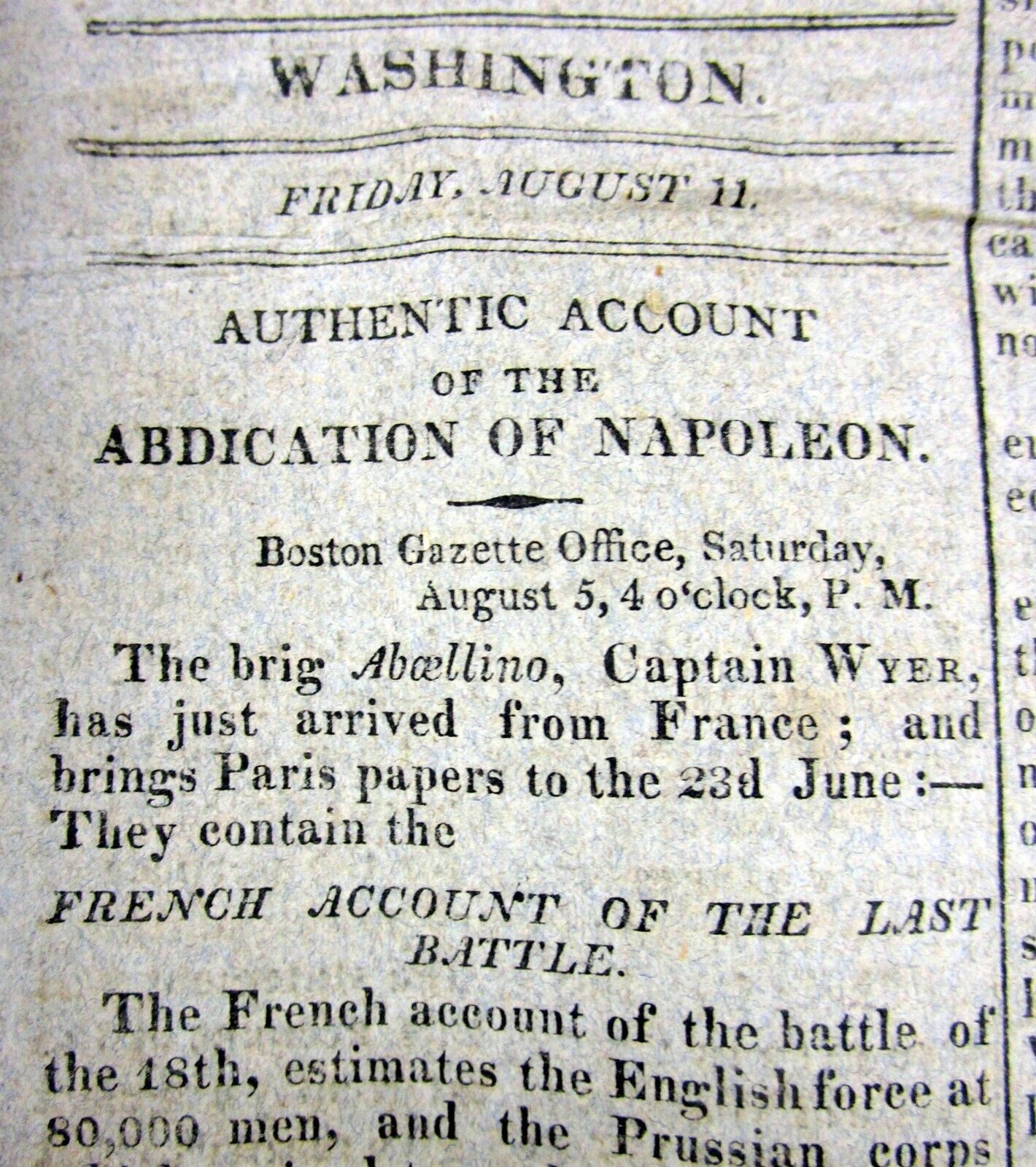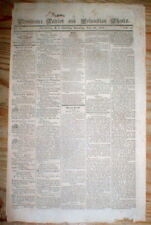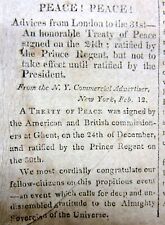|

On eBay Now...
1815 headline newspaper BATTLE of WATERLOO with ABDICATION of NAPOLEON BONAPARTE For Sale

When you click on links to various merchants on this site and make a purchase, this can result in this site earning a commission. Affiliate programs and affiliations include, but are not limited to, the eBay Partner Network.

1815 headline newspaper BATTLE of WATERLOO with ABDICATION of NAPOLEON BONAPARTE:
$78.00
1815 headline newspaper BATTLE of WATERLOO with the ABDICATION of NAPOLEON BONAPARTE
1815 headline newspaper with THE BATTLE of WATERLOO and the ABDICATION of NAPOLEON BONAPARTE as THE EMPEROR of FRANCE- inv # 6A-342 Please visit our store for THOUSANDS MORE HISTORICAL NEWSPAPERS for SALE or at sale SEE PHOTO(s) - COMPLETE ORIGINALNEWSPAPER,theNational Intelligencer(Washington, DC)datedAug 12. 1815.This original newspaper contains prominent front page \"stacked\": headlines and news coverage of the BATTLE OF WATERLOO and the ABDICATION of NAPOLEON BONAPARTE as the EMPEROR OF FRANCE.This issuemarks the final end of the NAPOLEONIC WARS of the early 19th Century as well as the \"end\" of NAPOLEON BONAPARTE as a World famousmilitary figure The Battle of Waterloo was fought on Sunday 18 June 1815, near Waterloo (at that time in the United Kingdom of the Netherlands, now in Belgium). A French army under the command of Napoleon was defeated by two of the armies of the Seventh Coalition. One of these was a British-led coalition consisting of units from the United Kingdom, the Netherlands, Hanover, Brunswick, and Nassau, under the command of the Duke of Wellington (referred to by many authors as the Anglo-allied army or Wellington\'s army). The other was composed of three corps of the Prussian army under the command of Field Marshal von Blücher (the fourth corps of this army fought at the Battle of Wavre on the same day). The battle marked the end of the Napoleonic Wars. The battle was contemporaneously known as the Battle of Mont Saint-Jean (France) or La Belle Alliance (\"the Beautiful Alliance\" – Prussia).Upon Napoleon\'s return to power in March 1815, many states that had previously opposed him formed the Seventh Coalition, while hurriedly mobilising their armies. Wellington\'s and Blücher\'s armies were cantoned close to the northeastern border of France. Napoleon planned to attack them separately in the hope of destroying them before they could join in a coordinated invasion of France with other members of the coalition. On 16 June, Napoleon successfully attacked the bulk of the Prussian army at the Battle of Ligny with his main force, causing the Prussians to withdraw northwards on 17 June, but parallel to Wellington and in good order.Napoleon sent a third of his forces to pursue the Prussians, which resulted in the separate Battle of Wavre with the Prussian rear-guard on 18–19 June, and prevented that French force from participating at Waterloo. Also on 16 June, a small portion of the French army contested the Battle of Quatre Bras with the Anglo-allied army. The Anglo-allied army held their ground on 16 June, but the withdrawal of the Prussians caused Wellington to withdraw north to Waterloo on 17 June.Upon learning that the Prussian army was able to support him, Wellington decided to offer battle on the Mont-Saint-Jean escarpment across the Brussels road, near the village of Waterloo. Here he withstood repeated attacks by the French throughout the afternoon of 18 June, aided by the progressively arriving Prussians who attacked the French flank and inflicted heavy casualties. In the evening, Napoleon assaulted the Anglo-allied line with his last reserves, the senior infantry battalions of the Imperial Guard. With the Prussians breaking through on the French right flank, the Anglo-allied army repulsed the Imperial Guard, and the French army was routed.Waterloo was the decisive engagement of the Waterloo campaign and Napoleon\'s last. According to Wellington, the battle was \"the nearest-run thing you ever saw in your life\". Napoleon abdicated four days later, and coalition forces entered Paris on 7 July. The defeat at Waterloo ended Napoleon\'s rule as Emperor of the French and marked the end of his Hundred Days return from exile. This ended the First French Empire and set a chronological milestone between serial European wars and decades of relative peace, often referred to as the Pax Britannica. Good condition. This listing includes thecomplete entire original newspaper, NOT just a clipping or a page of it. STEPHEN A. GOLDMAN HISTORICAL NEWSPAPERS stands behind all of the items that we sell with a no questions asked, money back guarantee. Every item we sell is an original newspaper printed on the date indicated at the beginning of its description. U.S. buyers paypriority mail postage which includes waterproof plastic and a heavy cardboard flat to protect the purchased itemfrom damage in the mail. Uponrequest by the buyer, we can ship by USPS Media Mail to reduce postage cost; however, please be aware that USPS Media Mailcanbe very slow in its time of transit to the buyer.International postage is quoted when we are informed as to where the package is to be sent. We do combine postage (to reduce postage costs) for multiple purchases sent in the same package. We list thousands of rare newspapers with dates from 1570 through 2004 on each week. This is truly SIX CENTURIES OF HISTORY that YOU CAN OWN! Stephen A. Goldman Historical Newspapers has been in the business of buying and selling historical newspapers for over 50 years. Dr. Goldman is a consultant to the Freedom Forum Newseum and a member of the American Antiquarian Society. You can buy with confidence from us, knowing that we stand behind all of our historical items with a 100% money back guarantee. Let our 50+ years of experience work for YOU ! We have hundreds of thousands of historical newspapers (and their very early precursors) for A. Goldman Historical Newspapershas been in the business of buying and selling historical newspapers for over 50 years. We are located in the charming Maryland Eastern Shore town of OXFORD, Maryland. Dr. Goldman is a consultant to the Freedom Forum Newseum and a member of the American Antiquarian Society. You can buy with confidence from us, knowing that we stand behind all of our historical items with a 100% money back guarantee. Let our 50+ years of experience work for YOU ! We have hundreds of thousands of historical newspapers (and their very early precursors) for sale.We invite customer requestsforhistorical newspapers that are not yetlocated in our extensive listing ofitems. With an inventory of nearlya million historical newspapers (and their early precursors) we arelikely have just the one YOU are searching for.WE ARE ALSO ACTIVE BUYERS OF HISTORICAL NEWSPAPERS, including large and small personal collections, bound volumes, significant individual issues, or deaccessions from libraries and historical societies. IF YOU WANT TO SELL, WE WANT TO BUY !!!
Powered by SixBit\'s eCommerce Solution


1815 headline newspaper INVENTION of the FIRST STEAM POWERED WARSHIP -The Fulton $25.00

1815 headline newspaper BATTLE of WATERLOO with ABDICATION of NAPOLEON BONAPARTE $78.00

1815 headline display newspaper announcing a PEACE TREATY ENDING the WAR of 1812 $140.00
|